A Coruna old town, the medieval district and more
In keeping with most Galician cities, A Coruna has a medieval or monumental district and this part of the town, referred to as simply "the city", still has some remnants of
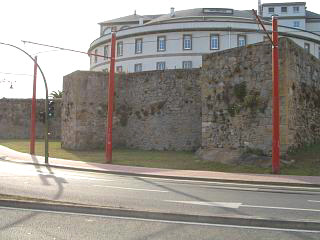 the old Roman wall that once enclosed and protected it.
the old Roman wall that once enclosed and protected it.
Right a section of A Coruna's old Roman wall at the boundary of the medieval quarter.
The old part of A Coruna town does not match up to neighbour, Santiago de Compostela, when it come to the size and age of its buildings, but it does have some areas that are well worth a visit.
We approached the old town from the bay area close to the "Castillo (castle) de San Anton" and passed by some large sections of the cities old wall, most of which has long
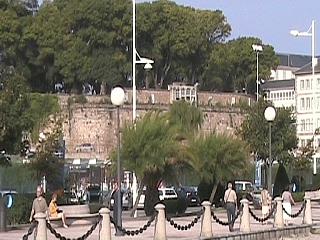 since disappeared. As you head for the old part of A Coruna from the Ocean side, you travel upwards and we passed by the "Museo Militar Regional" (military museum) which had some light artillery on display on its forecourt. To the side of this is the "Jardin de San Carlos", the walls of which can clearly be seen from the bay side below and which were once part of the fort of San Carlos (see photo above left). The fort was built in 1843 and the garden it now holds contains the tomb of Sir John Moore, famous in Galicia for his role in the battle of Elvina. This area also houses the Galician archive and has some city gates dating back to the fifteenth century close by.
since disappeared. As you head for the old part of A Coruna from the Ocean side, you travel upwards and we passed by the "Museo Militar Regional" (military museum) which had some light artillery on display on its forecourt. To the side of this is the "Jardin de San Carlos", the walls of which can clearly be seen from the bay side below and which were once part of the fort of San Carlos (see photo above left). The fort was built in 1843 and the garden it now holds contains the tomb of Sir John Moore, famous in Galicia for his role in the battle of Elvina. This area also houses the Galician archive and has some city gates dating back to the fifteenth century close by.
Churches in the medieval district
Still in the ancient part of the city, the "ciudad Vieja", there are three important churches. The first of these is one of A Coruna's oldest buildings, the Church of
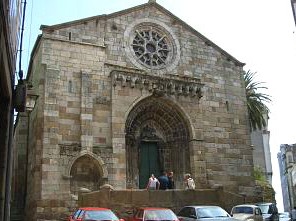 Santiago (Iglesia de Santiago). Originally built in the 12th century, it was modified in the 14th and 15th centuries and has huge historic significance on account of a 13th century statue of Saint James which it houses. Some of the more prominent aspects of the churches detailing originate from the fifteenth century and are gothic in design. The photo to the right shows the church of Santiago's main entrance.
Santiago (Iglesia de Santiago). Originally built in the 12th century, it was modified in the 14th and 15th centuries and has huge historic significance on account of a 13th century statue of Saint James which it houses. Some of the more prominent aspects of the churches detailing originate from the fifteenth century and are gothic in design. The photo to the right shows the church of Santiago's main entrance.
Also important in ecclesiastical terms is the "Iglesia de Santa Maria del Campo".
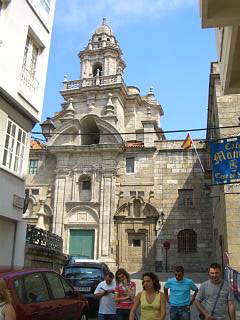 This church was constructed between the twelfth and fifteenth centuries and sits at what is probably the highest point in the city. This church has a museum archive within it (open to the public) containing pictures and documents created between the 12th and 15th centuries. It is famous throughout Spain. The church design is both Romanesque and gothic in style and, like the cathedral at Pontevedra, had much of its building costs financed by monies generated from the sea, in this case the "Guild of Seafarers".
This church was constructed between the twelfth and fifteenth centuries and sits at what is probably the highest point in the city. This church has a museum archive within it (open to the public) containing pictures and documents created between the 12th and 15th centuries. It is famous throughout Spain. The church design is both Romanesque and gothic in style and, like the cathedral at Pontevedra, had much of its building costs financed by monies generated from the sea, in this case the "Guild of Seafarers".
The third religious building in this vicinity is the church (photo to the left) and convent of Santo Domingo. Santo Domingo contains a chapel dedicated to A Coruna's patron, "La Virgen del Rosario". This convent is not as old as some of A Coruna's other buildings, but it is still worth a visit and is only a short distance away from the two churches described above.
More sights in A Coruna's old town
Located in "Tabernas Street" is the once home, now museum, of Emilia Pardo Bazan a famous Galician writer. This mansion dates back to the eighteenth century and is currently occupied by the Galician Academy.
Still staying in the general medieval part of la Corunna, other tourist stops of interest include a house where Rosalia de Castro (a Galician Poet) lived in 1873. By chance, another famous Galician writer also occupied the house next door.
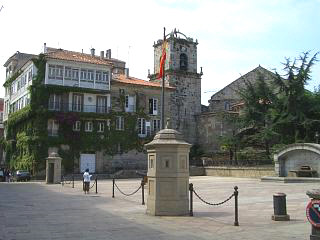
Just beyond these houses lies an important plaza called the Constitutional Square. This square has a large tiled area containing a cruceiro, fountain and a brace of cannons. It is faced by a large military building (of which there are many in A Coruna) and to the back of this square is where the church of Santiago can be found.
Above is the square, previously described, with the pitched roof of Santiago church in view, whilst below is yet another house in which the famed Galician poet, Rosalia de Castro, once lived.
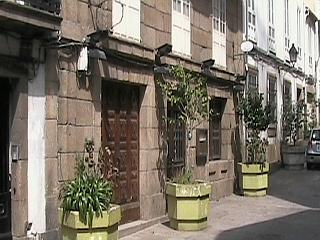
The Constitutional square (above) and Castro's house (right) are both on the same street in what is a small and compact monumental district.
Return to the A Coruna home page.

